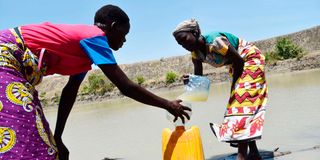Premium
Climate resilience lies in water conservation effort

Women fetch water at an almost dried-up water pan at Bora Imani in Magarini, Kilifi County on February 24, 2018.
The rains are here, finally. What relief! Nothing comes close to the unspeakable horrors populations in most of the Horn of Africa have endured in the past few years as the longest and acutest drought in a generation raged.
From Kajiado in Kenya to Hargeisa in Somalia, Oromia in Ethiopia and Uganda’s Karenga District, the devastation has been emphatic and irreversible.
The drought left millions of dead livestock, dehumanising poverty and damaging hopes in its wake. Some communities in the region will take years to restore their stock. Others will never recover.
In Africa, a protracted drought virtually always precedes heavy storms. And true to form, the end of the drought has occasioned heavy rains.
Before the mid-March rains, Mandera, a Kenyan town bordering Somalia and Ethiopia, had barely received rainfall in four years. When it came, the intensity and frequency were unbearable. Floods wreaked havoc.
It is apparent that as soon as one disaster eases its grip on the continent, another instalment of the climate curse strikes. This time more brutally. Astonishingly, though, most of the water from the ongoing rains will go down the drain—literally. As has been the norm, our people will savour the abundance of the commodity, farm and water their animals.
Meanwhile, little is being done to conserve some of this water. If the effects of climate change have been horrific, our preparedness for some of these events has been wanting. We enjoy a commodity in the season of plenty. Until scarcity strikes.
Lack capacity
It is arguable that our people lack the capacity to conserve water. On average, a 10000-litre plastic water tank in Kenya costs between $500 and $600 (Sh66,000 and Sh79,000). How many households can afford this type of money?
There is also a deficiency of awareness of the importance of collecting and storing rainwater. We must educate our people and remind them that we can no longer rely on rainwater to farm, for livestock and for other domestic uses.
More than 418 million Africans do not have access to clean drinking water, says Unicef. The scourge of climate change will make access harder in coming years, cutting off millions from the commodity.
Conservation is the way to go. Evidence of traditional water storage practices in Africa is widely documented. In eastern and northern Kenya, for instance, communities have been constructing rock catchments and sand dams to hold runoff water.
Sand dams are built across seasonal rivers in dryland environments and use rock outcrops to divert rainwater into a collection area. The water then passes through a filter system of sand before draining into large underground storage tanks.
These facilities not only store water but recharge groundwater as well. Some can store up to a million litres of water, thus guaranteeing water security while building the resilience of vulnerable communities.
The authorities have an urgent responsibility to incentivise communities to acquire water tanks and build water pans and other water storage facilities. We can either prepare for harsh weather events or sit and suffer the consequences. Let us choose preparedness. Readiness makes us more resilient.
Mr Adow is the founder and director of Power Shift Africa. @mohadow





